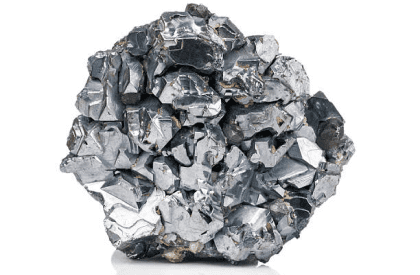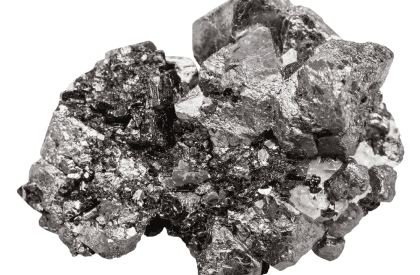Magnetite Iron
-
Carbon
Carbon
-
Copper
Copper
-
Tantalum
Tantalum
-
Coltan
Coltan
-
Magnetite Iron
Magnetite Iron
-
Manganese
Manganese
-
Graphite
Graphite
Our Brochures
Contact Us
Social Media


Magnetite is a mineral and one of the main iron ores. It is one of the oxides of iron, and is ferrimagnetic; it is attracted to a magnet and can be magnetized to become a permanent magnet itself. With the exception of extremely rare native iron deposits, it is the most magnetic of all the naturally occurring minerals on Earth. Naturally magnetized pieces of magnetite, called lodestone, will attract small pieces of iron, which is how ancient peoples first discovered the property of magnetism. Magnetite is black or brownish-black with a metallic luster, has a Mohs hardness of 5–6 and leaves a black streak. Small grains of magnetite are very common in igneous and metamorphic rocks.
Magnetite Chemical CompositionChemical Formula: Fe3O4
Magnetite belongs to the SPINEL GROUP, a group with the type formula XY2O4, where:
X = metal of valence 2 (Mg, Fe, Mn, Zn)
Y = trivalent metal (Al, Fe, Cr)
Magnetite contains both types of Fe (bi- and trivalent) so its formula can be written as follows:
Magnetite has the following composition (molecular weight of the empirical formula divided by the sums of the atomic weights of each element to obtain the percentage of each element):
72.36 % Fe 31.03 % FeO / 68.97 % Fe2O3
27.64 % O
Magnetite iron Crystal structure
¡According to the chemical formula of magnetite, it contains both ferrous (divalent) and ferric (trivalent) iron, suggesting crystallization in an environment with intermediate levels of oxygen.
The structure is inverse spinel. The structure is inverse spinel, with O2- ions forming a face-centered cubic lattice and iron cations occupying interstitial sites.Half of the Fe3+ cations occupy tetrahedral sites, while the other half, together with the Fe2+ cations, occupy octahedral sites. The unit cell consists of 32 O2- ions and the length of the unit cell is a = 0.839 nm. Magnetite can form solid solutions with minerals of similar structure, such as ulvospinel (Fe2TiO4) and magnesioferrite (MgFe2O4).
Titanomagnetite, also known as titaniferous magnetite, is a solid solution between magnetite and ulvospinel that crystallizes in many mafic igneous rocks.
Titanomagnetite can undergo oxy-exsolution during cooling, giving rise to magnetite and ilmenite encrustations.
Chemical And Physical Properties
Hard mineral, without exfoliation and fragile because it fractures easily parallel to the faces of the crystals, opaque, from dull to shiny. Ferromagnetic mineral (attracted by a magnet) and magnetopolar (it can maintain its magnetic properties for a long time, temporarily becoming a real magnet). It has an inverse spinel structure, where part of the trivalent iron is tetrahedrally coordinated and the rest and the bivalent iron are octahedrally coordinated. In addition, both the bivalent and trivalent Fe are partially substituted by elements such as Mn, Mg, Zn, Al Cr or Ti.
Parameter
Total iron, Fe
Magnetite, Fe3O4
Total humidity
Phosphorus, P
Sulfur, S
Aluminum, Al2O3
Calcium, CaO
Titanium, TiO2
Silicon, SiO2
Potassium, K2O
Magnesium, MgO
Manganese
Sodium, Na2O
Vanadium
Zinc
Specific Gravity, (kg/m3)
Magnetic Content
Typical analysis (%)
69
95,68
0,78
0,015
0,002
0,65
0,28
0,03
1,86
0,038
0,08
0,028
Ndl
Ndl
0,004
4,95 – 5,20
96
